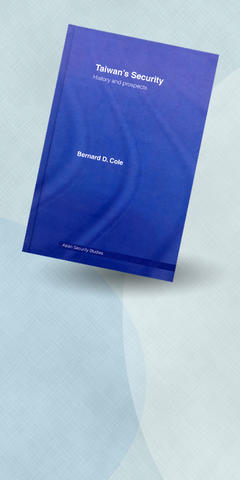In Taiwan's Security: History and Prospects, US Navy veteran Bernard Cole (unrelated to this reviewer) offers an unusually in-depth assessment of the many facets of Taiwan's defense establishment. While many publications have approached the subject from a quantitative perspective - how many tanks, aircraft, missiles and men Beijing would be capable of deploying against Taiwan in a symmetrical warfare scenario - Cole's book bores deep into Taiwanese society and highlights a series of social and institutional factors that would influence the outcome of a war with China.
Laying out the foundations to his argument, Cole contends that Taiwan's strategic positioning can be broken down into four phases - civil war; the 1949 to 1972 period of focusing on retaking China; the 1973 to 1990 transition from an offensive strategy to a defensive one; and the post-1991 emphasis on all-out defense. Parallel to these has been tutelage by the US, which while fearing that Chiang Kai-shek's (蔣介石) military adventurism in the 1950s risked sucking Washington into a war with China, nevertheless made great contributions to the modernization of the Taiwanese military.
Following his brief though sufficient historical overview, Cole then turns to the Chinese threat to Taiwan, one that has exploded in recent years with a leap in Beijing's modernization of its forces and renewed confidence in the place it occupies on the geopolitical map. Although, in Cole's view, the People's Liberation Army (PLA) continues to be dominated by army officers, a recent shift toward the PLA Air Force (PLAAF), accompanied by the acquisition and indigenous development of fourth-generation aircraft, increases the possibility of a military attack against Taiwan. The introduction of Russian-made Su-27s and Su-30s in the PLAAF also means that for the first time in years China could pose a serious challenge to Taiwan's F-16s and Mirage 2000s over the control of airspace across the Strait, although the proficiency of Chinese pilots remains in doubt.

The modernization of the PLA Navy also means that the balance of naval power in the Taiwan Strait is now in Beijing's favor. Cole argues that given Taiwan's geographical situation, mine warfare represents an especially serious threat to its economy and one it is ill-prepared and ill-equipped to deal with. China is also actively seeking aircraft carriers and mid-air refueling platforms, which would provide the PLAAF with the ability to attack Taiwan in an enveloping fashion rather than from a single direction.
In the past decade, Beijing has also markedly increased the number of DF-11 and DF-15 missiles it has deployed against Taiwan, which in his New Year speech President Chen Shui-bian (陳水扁) said now amounted to more than 1,300. Formidable though this threat may be, Cole argues, Taiwan's ballistic-missile defense systems, complemented by the ongoing relocation and hardening of high-value targets, could make it likelier that a missile attack against Taiwan would not be devastating. However, he notes that China has actively pursued the development of cruise missiles, which are much more difficult to intercept.
Cole follows his exposition of the PLA threat with a thorough, cubicle-by-cubicle look at the Taiwanese military establishment, dissecting one organization after another and explaining their roles and challenges, all the while emphasizing the need for greater cooperation and integration between the services. While this section is unlikely to appeal to the general reader, it nevertheless symbolizes Taiwan's openness to discuss these matters with researchers like Cole - something that would be unimaginable on the PRC side - and willingness to learn and improve.
Where Cole's book really stands out from other publications is in its analysis of the impact democratization, civilianization of the military and the attempt to achieve an all-volunteer service have had on Taiwan's military preparedness and ability to defend itself. Likening the Democratic Progressive Party administration's commendable, albeit daunting, attempt to create a professional defense bureaucracy to the US implemention of the Defense Reorganization Act of 1947 and the Goldwater-Nichols Act of 1986 simultaneously, Cole nevertheless identifies deficiencies in the process: a lack of funding and the failure, so far, to attract enough volunteers. Compulsory service, now at 12 months, is also far too short, in Cole's assessment, to provide soldiers with the training they need to operate in a 21st-century military. There is little doubt that democracy imposes an additional burden on national defense, as seen for example in the battle over the special arms acquisition budget and overall defense spending - something the authoritarian regime in Beijing does not have to contend with - versus other national concerns such as development and the environment.
Throughout his book, Cole also touches on a shift in Taiwan's posture from one of "passive defense" to "active defense," wherein Taipei's strategy would be to present Beijing with a credible deterrent and take the battle away from Taiwan and into China. Although this remains controversial, Taiwan's development of offensive weapons such as the Hsiung Feng III, the Hsiung Feng IIE and Tien Kung III, as well as "blackout" bombs, represents a step in that direction and recognition on Taiwan's part that purely defensive action against an overwhelming adversary might not be feasible. Aside from obvious military targets in the PRC identified by Cole, such as missile batteries and command centers, China's current fuel shortage and how this would affect its ability to sustain an attack on Taiwan should inspire Taipei to look at the possibility of targeting fuel depots there.
In the end, Cole argues, Taiwan must decide how much capital and human resources it is willing to invest in its defenses, which sends a message to its allies about how serious it is about protecting its hard-earned democracy. Although the US remains a committed ally, its responsibilities elsewhere mean that a speedy US intervention in the Taiwan Strait should not be taken for granted. Building a capability to hold the line for 15 days - Taipei's current strategy - therefore might not be enough.

Seven hundred job applications. One interview. Marco Mascaro arrived in Taiwan last year with a PhD in engineering physics and years of experience at a European research center. He thought his Gold Card would guarantee him a foothold in Taiwan’s job market. “It’s marketed as if Taiwan really needs you,” the 33-year-old Italian says. “The reality is that companies here don’t really need us.” The Employment Gold Card was designed to fix Taiwan’s labor shortage by offering foreign professionals a combined resident visa and open work permit valid for three years. But for many, like Mascaro, the welcome mat ends at the door. A

If China attacks, will Taiwanese be willing to fight? Analysts of certain types obsess over questions like this, especially military analysts and those with an ax to grind as to whether Taiwan is worth defending, or should be cut loose to appease Beijing. Fellow columnist Michael Turton in “Notes from Central Taiwan: Willing to fight for the homeland” (Nov. 6, page 12) provides a superb analysis of this topic, how it is used and manipulated to political ends and what the underlying data shows. The problem is that most analysis is centered around polling data, which as Turton observes, “many of these

Divadlo feels like your warm neighborhood slice of home — even if you’ve only ever spent a few days in Prague, like myself. A projector is screening retro animations by Czech director Karel Zeman, the shelves are lined with books and vinyl, and the owner will sit with you to share stories over a glass of pear brandy. The food is also fantastic, not just a new cultural experience but filled with nostalgia, recipes from home and laden with soul-warming carbs, perfect as the weather turns chilly. A Prague native, Kaio Picha has been in Taipei for 13 years and

Since Cheng Li-wun (鄭麗文) was elected Chinese Nationalist Party (KMT) chair on Oct. 18, she has become a polarizing figure. Her supporters see her as a firebrand critic of the ruling Democratic Progressive Party (DPP), while others, including some in her own party, have charged that she is Chinese President Xi Jinping’s (習近平) preferred candidate and that her election was possibly supported by the Chinese Communist Party’s (CPP) unit for political warfare and international influence, the “united front.” Indeed, Xi quickly congratulated Cheng upon her election. The 55-year-old former lawmaker and ex-talk show host, who was sworn in on Nov.